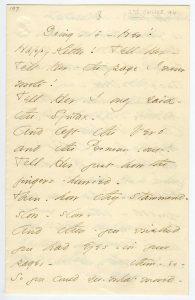Going – to – Her!
Happy – Letter! Tell Her –
Tell Her – the page I never
wrote!
Tell Her, I only said –
the Syntax –
And left the Verb
and the Pronoun – out!
Tell Her just how the
fingers – hurried –
Then – how they – stammered –
slow – slow –
And then – you wished
you had eyes – in your
pages –
So you could see – what moved –
them – so –
Tell Her – it was’nt
a practised Writer –
You guessed –
From the way the sen –
tence – toiled –
You could hear the
Boddice – tug – behind you –
As if it held but the
might of a Child!
You almost pitied – it –
you – it worked so –
Tell Her – No – you may
quibble – there –
For it would split Her
Heart – to know it –
And then – you and I –
were silenter!
Tell Her – Day – finished –
before we – finished –
And the old Clock
kept neighing – “Day”!
And you – got sleepy –
And begged to be ended –
What could – it hinder
so – to say?
Tell Her – just how she
sealed – you – Cautious!
But – if she ask “where you are hid” – until the
evening –
Ah! Be bashful!
Gesture Coquette –
And shake your Head!
Link to EDA manuscript. Originally in Amherst Manuscript # 197. Courtesy of Amherst College, Amherst, MA. First published in Poems (1891), 94-95, as three eight-line stanzas from F277C, “Going to him! Happy letter!”
This poem from 1862 exists in three versions: “Going – to – her!” “Going to him!” and “Going to them!” and illustrates Dickinson’s ability to adapt her emotional effusions across genders and types of relations. The speaker of the poem says that she has “left the Verb and the Pronouns – out,” but, in fact, Dickinson has put a proliferation of pronouns in!
Farr includes this poem in the Sue cycle, where it illustrates the speaker’s flirtatious elation tinged by trepidation in imagining her letter “going” to a female correspondent, perhaps across the hedges to The Evergreens and Sue. It is unclear whether Dickinson sent it to Sue or perhaps sent it as a draft. Franklin notes,
The earlier of the surviving manuscripts, from about early 1862, is on embossed notepaper and signed “Emily,” but not addressed or folded (A 197). It was ED’s record for the poem, the working draft of which she destroyed.
Franklin continues:
About later summer 1862, ED made another fair copy (A 689), apparently from the earlier one. The later copy, on embossed notepaper, was signed “Emily”’ and has been folded. Although prepared as if for a recipient, the manuscript remained among ED’s own papers. It was not sent to Samuel Bowles.
This is the version with the male pronouns. Another “lost manuscript, sent to Louise and Frances Norcross, was described by Mable Todd;” this one uses the plural pronoun.
What we might note about this poem are the thematic ellipses, the absences, what is left out. The speaker commands the letter she is writing to tell its recipient about “the page I never wrote!” What has been held back or omitted? What cannot or will not be said? And why then tell about it ? Many scholars speculate that Dickinson wrote to Sue in a coded language that could be read by Austin and others who carried letters for her and not deciphered, but here the speaker refers to the omitted page as, in some way, the most precious and important.
Each stanza ends on a moment of intensity. In the first stanza the speaker’s surmise of the letter’s wish that it “had eyes – in your pages” so it could see the emotion that moved the stammering fingers of the writer suggests feelings unutterable deep. In the second stanza, the speaker urges the letter to tell how the writer’s heart pounded “as if it held but the might of a Child!” But then fears this would break the recipient’s heart. In the last stanza, the speaker enjoins the letter not to tell where it was hidden until it could be sent–rendering the imagined place exquisitely alluring.
Sources
Farr, Judith. The Passion of Emily Dickinson. Harvard University Press, 2004, especially pp. 100-177.
Dickinson, Emily. The Poems of Emily Dickinson: Variorum Edition. Ed. R. W. Franklin. Cambridge: the Belknap Press of Harvard University, 1998, 294-96.


